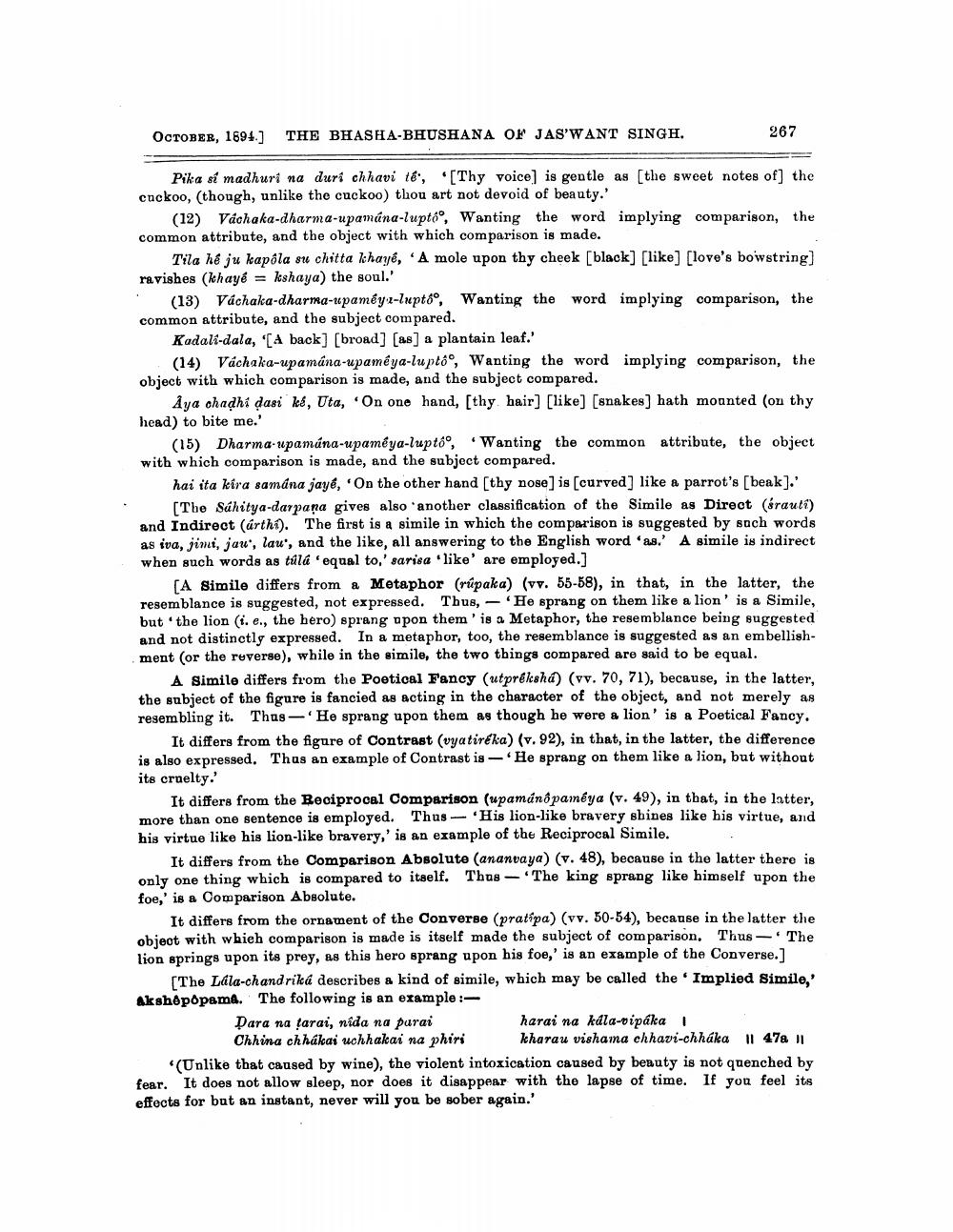________________
THE BHASHA-BHUSHANA OF JAS'WANT SINGH.
267
OCTOBER, 1894.]
Pika si madhuri na duri chhavi te, [Thy voice] is gentle as [the sweet notes of] the cuckoo, (though, unlike the cuckoo) thou art not devoid of beauty.'
(12) Váchaka-dharma-upamana-lupté, Wanting the word implying comparison, the common attribute, and the object with which comparison is made.
Tila hé ju kapôla su chitta khayê, 'A mole upon thy cheek [black] [like] [love's bowstring] ravishes (khayé kshaya) the soul.'
(13) Váchaka-dharma-upaméya-lupto, Wanting the word implying comparison, the common attribute, and the subject compared.
Kadali-dala, [A back] [broad] [as] a plantain leaf.'
(14) Váchaka-upamana-upamêya-lupto, Wanting the word implying comparison, the object with which comparison is made, and the subject compared.
Aya chadhi dasi ké, Uta, On one hand, [thy hair] [like] [snakes] hath mounted (on thy head) to bite me.'
(15) Dharma upamana-upaméya-lupto, Wanting the common attribute, the object with which comparison is made, and the subject compared.
hai ita kira samana jayé, 'On the other hand [thy nose] is [curved] like a parrot's [beak].'
[The Sahitya-darpana gives also another classification of the Simile as Direct (érauti) and Indirect (árthi). The first is a simile in which the comparison is suggested by such words as iva, jimi, jau, lau', and the like, all answering to the English word 'as. A simile is indirect when such words as túlú 'equal to,' sarisa 'like' are employed.]
[A Simile differs from a Metaphor (rúpaka) (vv. 55-58), in that, in the latter, the resemblance is suggested, not expressed. Thus, 'He sprang on them like a lion' is a Simile, but the lion (i. e., the hero) sprang upon them' is a Metaphor, the resemblance being suggested and not distinctly expressed. In a metaphor, too, the resemblance is suggested as an embellishment (or the reverse), while in the simile, the two things compared are said to be equal.
A Simile differs from the Poetical Fancy (utpreksha) (vv. 70, 71), because, in the latter, the subject of the figure is fancied as acting in the character of the object, and not merely as resembling it. Thus-He sprang upon them as though he were a lion' is a Poetical Fancy.
It differs from the figure of Contrast (vyatiréka) (v. 92), in that, in the latter, the difference is also expressed. Thus an example of Contrast is He sprang on them like a lion, but without its cruelty.'
It differs from the Reciprocal Comparison (upamánôpaméya (v. 49), in that, in the latter, more than one sentence is employed. Thus 'His lion-like bravery shines like his virtue, and his virtue like his lion-like bravery,' is an example of the Reciprocal Simile.
It differs from the Comparison Absolute (ananvaya) (v. 48), because in the latter there is only one thing which is compared to itself. Thus 'The king sprang like himself upon the foe,' is a Comparison Absolute.
It differs from the ornament of the Converse (pratipa) (vv. 50-54), because in the latter the object with which comparison is made is itself made the subject of comparison. Thus - The lion springs upon its prey, as this hero sprang upon his foe,' is an example of the Converse.]
[The Lala-chandrika describes a kind of simile, which may be called the Implied Simile,' Akshopopama. The following is an example:
Dara na tarai, nida na parai
Chhina chhúkai uchhakai na phiri
harai na kala-vipáka
kharau vishama chhavi-chhaka 11 478 ||
'(Unlike that caused by wine), the violent intoxication caused by beauty is not quenched by fear. It does not allow sleep, nor does it disappear with the lapse of time. If you feel its effects for but an instant, never will you be sober again.'




